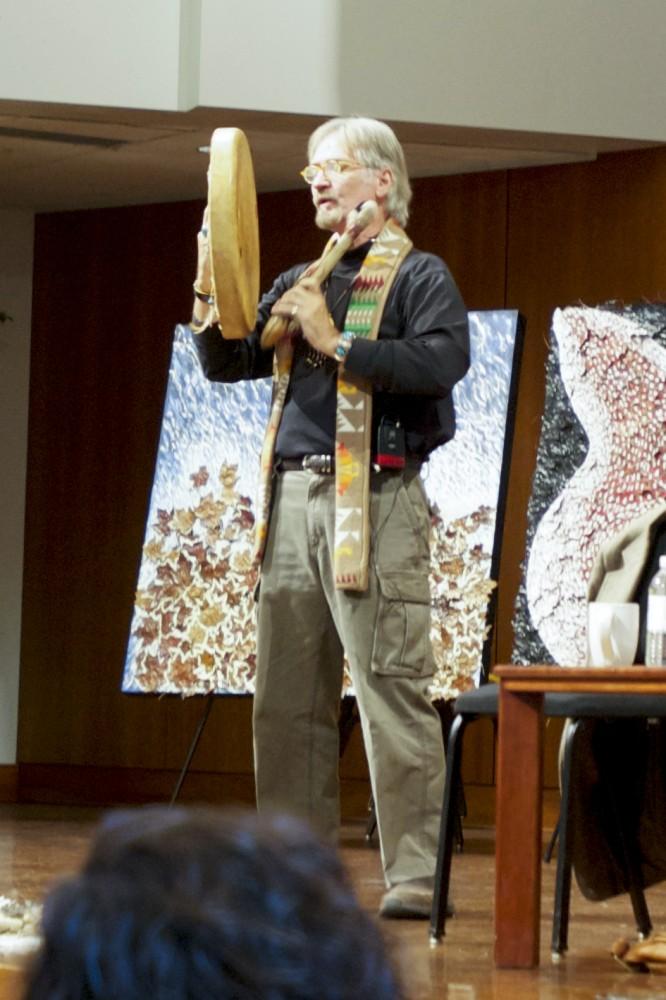Shamanism gains interest at GVSU

C. Michael Smith, Ph.D, preforms a chant before beginning his lecture “Why Shamanism Now?” last Wednesday.
Oct 17, 2010
With the thundering of drums, the noise in the Cook-Dewitt auditorium fell to a murmur. It was a call to order, a call to listen, a call to commune with the planet that sustains us.
Shaman C. Micheal Smith, also known as Mikkal, spoke to an audience of Grand Valley State University students and faculty Wednesday about the recent resurgence of interest in shamanism. Smith is a shamanic healer, Jungian psychologist, clinical psychologist and medical anthropologist – he has been practicing shamanism for 30 years. Smith also founded the Crow’s Nest Center for Shamanic Studies.
Smith’s discussion, titled “Why Shamanism Now?,” expressed why he feels that the world needs the ideas of the shaman now more than ever. Shamanism is way for people to commune with the spirit of the world around them for the purpose of healing, whether it be the healing of a physical wound, the spirit or the world.
“A Shaman is a specialist in the sacred,” Smith said. “He takes a visionary journey into the other world.”
Despite common misconceptions, shamanism is not a religion. In fact, the practices of a shaman can work within the spiritual framework of any religious tradition. Maureen Wolverton, a GVSU liberal studies professor and organizer of the event, said that when trying to perform a healing, it is extremely relevant to the shaman to know the spiritual center of his or her client.
“It has always used the sacred stories of whatever religion is prominent to do the healing work,” Wolverton said.
During his talk, Smith walked the audience through a brief history of the shaman and how they go about communicating with the spirits of the world. Smith said there are three different worlds that exist within all of us — the upper world, the lower world and the world in which we currently live.
“This three-story [system] is really the shaman’s conception of the divine,” Smith said.
He added that a shaman can enter a controlled, but sometimes spontaneous, state of meditation through which they may get down into these worlds and seek the divine great spirit. The interactions that the shaman has with the images they see during these meditations are considered to be a form of intercessory prayer.
“The divine is not something out there,” Smith said. “It is considered to be inside us.”
To that effect, the shaman is meant to be humble and reverent and let the great spirit work through them, Wolverton explained.
“The goal [of the shaman] is to be a hollow bone so the spirit can speak through you,” she said.
Smith went on to describe a prophecy that once came to a shaman by the name of Black Elk. In this vision, Black Elk saw a blue man walking among the world.
“The blue man is that in us that is greedy, materialistic … always wanting something,” he said.
The blue man represents a disease which is infecting the earth. Smith said that this is why we need Shamanism now more than ever – the things that the blue man represents are things which are produced by the mind of man.
Smith said he believes the great spirit resides in our hearts, not in our minds and that now that the planet is in such danger of being destroyed, more people are becoming astute to the shaman’s ways. He said that the wisdom of the great spirit flows through that person’s heart.
“It seems as though we’re living in a time where there’s a shift about to occur about how we think about our resources,” Wolverton said. “We realize that we need to change the way that we interact with this earth.”
This semester, Wolverton is teaching a course called “Jung and Shamanism.” She said the class attracted a wide variety of students that all want to know about how to connect with the world around them.
Natalie Trevino, a peace studies majorcurrently enrolled in the class, said she was surprised at how many people attended the event and at how diversified the crowd was.
“I was happy with the diverse nature [of the crowd], from people wearing Tye-dye to people wearing suites,” she said.

























